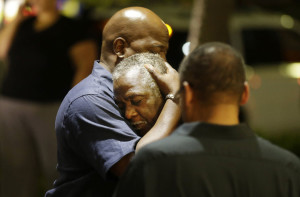Two days ago, a young white man gunned down nine African Americans at a church in Charleston, South Carolina.
When confronted with such a brutal, violent act, it is tempting to dismiss the killer as an anomaly—mentally ill or emotionally disturbed, perhaps—instead of recognizing the roots of his behavior in the shared history, culture, and institutions of our society. But viewing these murders as an isolated incident obscures their connection to a larger pattern of racial violence that is as old as the United States of America.
I recently read the memoir of a lawyer named Bryan Stevenson who spent years working to free innocent men on death row, and advocating for children and individuals with mental illness or intellectual disabilities who are serving life sentences or awaiting execution. His book Just Mercy is a heartbreaking look at mass incarceration and extreme punishment in America, and his decades of personal involvement in the criminal justice system reveal the blatant influence of race in determining how Americans are treated by police, courts of law, and prison authorities.
Stevenson illuminates the concrete effects of racism on the lives of black Americans by explaining “four institutions in American history that have shaped our approach to race and justice”:
- Slavery. African Americans were considered property rather than human beings with rights.
- The “Reign of Terror” between Reconstruction and World War II. After 9/11, it was common to hear news anchors and politicians alike referring to this attack as the first time Americans had experienced terrorism within our own country. But as Stevenson explains, the fear of violence was nothing new for African Americans who grew up in the South between the Civil War and the Civil Rights movement. As one man told him, “We grew up with terrorism all the time. The police, the Klan, anybody who was white could terrorize you. We had to worry about bombings and lynchings, racial violence of all kinds.” Stevenson argues that “America’s embrace of speedy executions was, in part, an attempt redirect the violent energies of lynching while assuring white southerners that black men would still pay the ultimate price.” Today, the pairing of a black perpetrator with a white victim still results in the death penalty more often than crimes involving a white perpetrator or a black victim.
- Segregation and human rights violations under “Jim Crow.” The Supreme Court didn’t strike down laws against interracial marriage until 1967 in Loving v. Virginia, but marriage between whites and blacks remained illegal under the Alabama state constitution until the year 2000 (and even then, 41% of Alabama voters cast their ballots in favor of upholding the ban). In 1945, Stevenson points out, “the Supreme Court upheld a Texas statute that limited the number of black jurors to exactly one per case,” and after the passage of the Voting Rights Act in 1965, many southern states continued to exclude African Americans from serving on juries at all.
- Mass incarceration today. The United States has the highest rates of incarceration of anywhere in the world, and the vast majority of the 2.3 million people currently in prison are black or brown. People of color are often arrested and sentenced for the kind of nonviolent drug offenses that white teenagers and college students engage in without consequence, and frequent police harassment increases the likelihood of black and Latino teenagers developing criminal records. Stevenson argues (as did Michelle Alexander in her 2010 book, The New Jim Crow) that mass incarceration functions to control and disenfranchise African Americans in much the same way that Jim Crow did in the past. Some states permanently take away the right to vote from anyone with a criminal conviction, which means that there are now several states in which a higher percentage of African American men are barred from voting now than were disenfranchised before the Voting Rights Act of 1965.
These institutions stretch from the birth of the American nation down to today, showing that racism is not an imagined problem, a historical phantom long since put to rest, or the extreme ideology of some fringe individuals in society. Racism is embedded in our history, our culture, and our civic institutions. It’s not something that will fade out automatically—it’s a glaring problem that all of us need to confront as a nation and in our own hearts and minds.
Recognizing our fears or ignorance about people who are unlike us does not make us bad or hateful people. If we want to walk in the truth and to love our neighbors well, then we must be willing to acknowledge the ways we subtly buy into untrue assumptions about people of other races, or support policies and institutions which negatively impact their lives. An ongoing process of critical self-reflection is necessary for anyone who wants to live a just and compassionate life, and it is especially important for those of us in the racial majority who have never experienced discrimination.
In the wake of yet another tragedy, I am grieving with the families of the slain. But grieving is not enough. White America has two choices: we can continue to look away from the festering wound of racism in our society, or we can confront our past and our present in order to pursue a different future on the basis of truth and reconciliation.
